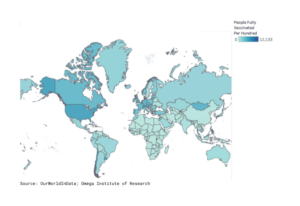- Industries
Industries
- Functions
Functions
- Insights
Insights
- Careers
Careers
- About Us
- Healthcare
- By Omega Team

A vaccine is a preventive substance stimulate the production and provide immunity against diseases.To understand the mechanism of vaccines, we need to know how the immune system works. The main part of the immune system responsible for killing pathogens(1) is called T cells. When Naive T cells are exposed to pathogens, they undergo activation, become Effector T cells and acquire the ability to kill pathogens. After the death of these pathogens, a small number of Effector T cells remain as Memory T cells.
They document the characteristics of the dead pathogen, in case they encounter the same pathogen again. This ability of Memory T cells is the main reason we have been able to develop vaccines. The vaccine is injected into the body to help it make the appropriate memory T cells without undergoing a pathological reaction and produce immune effect to achieve the effect of prevention.
Figure 1: Two proposed models for memory T cell formation

History of Vaccines
The world’s first vaccine was developed in 1796 by Edward Jenner in Britain, using a virus from cattle. Smallpox is a severe infectious disease with high infectivity and mortality. Jenner discovered that the milkmaid did not get smallpox after getting cowpox from the cows. To test this idea, in 1796 he injected a small amount of pus from the scar of a milkmaid into the arm of a boy. The boy was infected with cowpox and after six weeks, the cowpox reaction subsided. Jenner published his monograph Inquiry in 1798, calling this technique vaccination. Vaccines were invented at a time when the mechanism of virus infection and immunity was still unknown.
In 1980, the World Health Assembly officially declared that smallpox, which had decimated countless lives around the world, had been eradicated worldwide. The defeat of smallpox was one of the greatest events in the history of preventive medicine. With the rapid development of molecular biotechnology, biochemistry, genetics and immunology, the theoretical basis and technical level of vaccine development have been constantly improved. Some traditional vaccine varieties have been further transformed into new ones, while ways have been found to develop new vaccines that are not available through traditional techniques.
Types of Vaccines
There are several different types of vaccines. When scientists create vaccines, they consider how the immune system responds to the pathogens, who needs to be vaccinated against them and what is the best technology or approach to creating the vaccine. Based on a number of these factors, scientists decide which type of vaccine they will make. There are several types of vaccines, including:
Inactivated vaccines
Inactivated vaccines use the killed version of the pathogen that causes a disease. Inactivated vaccines usually don’t provide immunity (protection) that’s as strong as live vaccines. So you may need several doses over time (booster shots) in order to get ongoing immunity against diseases. Inactivated vaccines are used to protect against hepatitis A, flu, polio and rabies.
Live-attenuated vaccines
Live vaccines use a weakened (or attenuated) form of the pathogen that causes a disease. Because these vaccines are so similar to the natural infection that they help prevent, they create a strong and long-lasting immune response. Just 1 or 2 doses of most live vaccines can give you a lifetime of protection against a pathogen and the disease it causes.
But live vaccines also have some limitations. Because they contain a small amount of the weakened live virus, some people should talk to their health care provider before receiving them, such as people with weakened immune systems, long-term health problems, or people who’ve had an organ transplant. In addition, they need to be kept cool, so they don’t travel well. That means they can’t be used in countries with limited access to refrigerators.
Live vaccines are used to protect against: measles, mumps, rubella (MMR combined vaccine), Rotavirus(2), smallpox, chickenpox and yellow fever.
Messenger RNA vaccines—also called mRNA vaccines
Researchers have been studying and working with mRNA vaccines for decades and this technology was used to make some of the COVID-19 vaccines. RNA vaccines work by introducing an mRNA sequence (the molecule which tells cells what proteins to build) which is coded for a disease-specific antigen; once produced within the body, the antigen is recognized by the immune system, preparing it to fight the real thing. mRNA vaccines have several benefits compared to other types of vaccines, including shorter manufacturing times and, because they do not contain a live virus, no risk of causing disease in the person getting vaccinated.
Sub-unit, recombinant, polysaccharide, and conjugate vaccines
These vaccines use specific pieces of the pathogen—its protein, sugar, or capsid (a casing around the pathogen). Because these vaccines use only specific pieces of the pathogen, they give a very strong immune response that’s targeted to key parts of the pathogen. They can also be used on almost everyone who needs them, including people with weakened immune systems and long-term health problems.
One limitation of these vaccines is that you may need booster shots to get ongoing protection against diseases. These vaccines are used to protect against: Hib (Haemophilus influenzae type b) (3) disease, hepatitis B, human papillomavirus (HPV) (4), whooping cough (part of the DTaP combined vaccine), pneumococcal disease (5), meningococcal disease (6) and shingles.
Toxoid vaccines
Toxoid vaccines use a toxin (harmful product) made by the pathogen that causes a disease. They create immunity to the parts of the pathogen that cause disease instead of the pathogen itself. That means the immune response is targeted to the toxin instead of the whole pathogen. Same to some other types of vaccines, you may need booster shots to get ongoing protection against diseases. These vaccines are used to protect against diphtheria and tetanus.
Viral vector vaccines
For decades, scientists studied viral vector vaccines. Some vaccines recently used for Ebola outbreaks have used viral vector technology, and a number of studies have focused on viral vector vaccines against other infectious diseases such as Zika (7), flu, and HIV. Scientists used this technology to make COVID-19 vaccines as well. Viral vector vaccines use a modified version of a different virus as a vector to deliver protection. Several different viruses have been used as vectors, including influenza, vesicular stomatitis virus (VSV) (8), measles virus, and adenovirus, which causes the common cold. Adenovirus (9) is one of the viral vectors used in some COVID-19 vaccines being studied in clinical trials.
Therapeutic Vaccines
With the development of immunology research, it is hoped that vaccines can be used to treat diseases or prevent the deterioration of diseases by inducing specific immune responses in infected individuals. Such vaccine products are therapeutic vaccines.
Therapeutic vaccines are currently under development:
For the treatment of tumor, the therapeutic effect of tumor vaccine is to use tumor antigen for active immunity, stimulate the body’s active specific immune response to tumor, so immune response to tumor, so as to prevent tumor growth, diffusion and metastasis.
For the treatment of diseases of the cardiovascular system: encouraging progress has been made in the prevention and development of atherosclerosis (AS) (10) by vaccine intervention in the immune process.
Treatment for hypertension: Preliminary results from a Phase II clinical trial show that a vaccine for hypertension, cyt006-ANGQb, has good clinical development prospects, according to Cytos Biotech of Switzerland.
For the treatment of type 1 diabetes: There are 3 types of vaccines for type 1 diabetes that have entered the clinical research stage announced by FDA in the United States.
COVID-19 & mRNA technologies
The vaccine field has been forever transformed and advanced because of COVID-19. Messenger RNA (mRNA) — the basis of the first two vaccines cleared for public use by the Food and Drug Administration (FDA) — induces cells to set off an immune response against the coronavirus that causes COVID-19. Vaccine researchers believe the success of these inoculations will usher in the most radical change to vaccine development since Jenner tapped a cow virus two centuries ago.
Researchers say mRNA can be used to create a variety of vaccines and treatments in less time and at lower costs than traditional methods. The vaccines’ use against COVID-19 will produce more evidence about the effectiveness and safety of this approach.
The Future of Vaccines
The Market growth
The global vaccines market is expected to decline from $56.02 billion in 2020 to $55.97 billion in 2021 at a compound annual growth rate (CAGR) of -0.1%. The slow decline is mainly due to the outbreak of COVID-19 that has led to the deferment of immunocompromised treatments. The market is expected to reach $85.93 billion in 2025 at a CAGR of 11.3%. Major players in the vaccines market are AstraZeneca, Emergent Biosolutions, GlaxoSmithKline, Merck, and Pfizer Inc.
The COVID-19 pandemic has changed the vaccine market dramatically. As of September 2021, more than 5.6B doses of COVID-19 vaccine have been given globally, and 2.3 billion people, 29.8% of the global population, have been fully vaccinated. The size of the COVID-19 vaccine market across the seven major markets – the US, Germany, France, Italy, Spain, the UK, and Japan -is estimated to increase from $13.6 B in 2021 to $19.5 B in 2026 at a compound annual growth rate (CAGR) of 7.6% should annual vaccination be required, according to GlobalData.
Figure 2: People Fully Vaccinated Per Hundred by Country

Focuses of Innovations
Sustained investment and effective introduction of new technologies are essential to enable vaccine-preventable diseases to be controlled, eliminated and potentially eradicated.
Pharmaceutical companies are innovating for the next generation of vaccines. Over 260 vaccines are in development for the prevention or treatment of disease, and new technologies are helping us find potential new vaccines. At the same time, they are also looking at ways to make vaccines more effective and easier to use. That’s especially important for infectious diseases impacting parts of the world without developed health care systems. That research includes reducing the need for multiple doses of a vaccine by boosting the body’s immune response, improving manufacturing processes to deliver vaccine doses more quickly and making transportation and storage of vaccines easier to reduce wastage and improve access for hard to reach communities.
Glossary
(1) Pathogen: a bacterium, virus, or other microorganism that can cause disease.
(2) Rotavirus: Rotaviruses are the most common cause of diarrhoeal disease among infants and young children. Nearly every child in the world is infected with a rotavirus at least once by the age of five.
(3) Hib: a bacterial illness that can lead to a potentially deadly brain infection in young children.
(4) Human papillomavirus (HPV): is a viral infection that’s passed between people through skin-to-skin contact. There are over 100 varieties of HPV, more than 40 of which are passed through sexual contact and can affect your genitals, mouth, or throat.
(5) Pneumococcal disease: caused by common bacteria that can attack different parts of the body.
(6) Meningococcal disease: a serious bacterial illness that can lead to severe swelling of the tissues surrounding the brain and spinal cord or infection of the bloodstream.
(7) Zika: A disease caused by Zika virus that’s spread through mosquito bites. Symptoms include fever, rash, joint pain, and red eyes.(8) Vesicular stomatitis virus (VSV): a virus family infect cattle, horses and pigs. It is zoonotic and leads to a flu-like illness in infected humans.
(9) Adenoviruses: common viruses that cause a range of illness. They can cause cold-like symptoms
(10) Atherosclerosis (AS): a disease of the arteries characterized by the deposition of plaques of fatty material on their inner walls.Subscribe
Select topics and stay current with our latest insights
- Functions